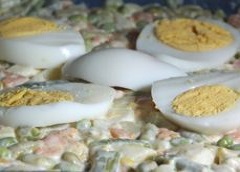Salad Olivier Recipe and History
July 22, 2017
Salad Olivier has the constant presence on a party table for each festivity celebrated by Russian Speaking community, but it holds a special honorary place on the dinner table of every family celebrating New Year’s. The recipes are different depending on a family tradition but the core and the meaning are the same.
In honor of upcoming New Year we have held a contest in our Fecebook Group on the best Olivie recipe and picture.
Here is the picture and recipe of Olivier Salad by Group Member Lena Bar which was most liked in our Russian Insider Group:
Ingredients: potatoes, carrots,onion, bologna, eggs, canned sweet peas, pickles, mayo, salt and pepper. Boil potatoes, carrots, eggs until soft. Drain and rinse with cold water until cold. Take off skin from potatoes and carrots. Dice potatoes, eggs, carrots, bologna, onion and pickles. Add drained sweet peas. Stir mayonnaise, salt, and black pepper gently into the mixture. Put into fridge to cool off for at least 30 min.
The invention history of our beloved salad is stated in Wikipedia:
“The original version of the salad was invented in the 1860s by Belgian Lucien Olivier, the chef of the Hermitage, one of Moscow’s most celebrated restaurants. Olivier’s salad quickly became immensely popular with Hermitage regulars, and became the restaurant’s signature dish.Olivier cooked by recipe of Hermitage restaurant
The exact recipe — particularly that of the dressing — was a jealously guarded secret, but it is known that the salad contained grouse, veal tongue, caviar, lettuce, crayfish tails, capers, andsmoked duck, although it is possible that the recipe was varied seasonally.
The original Olivier dressing was a type of mayonnaise, made with French wine vinegar, mustard, and Provençal olive oil; its exact recipe, however, remains unknown.
At the turn of the 20th century, one of Olivier’s sous-chefs, Ivan Ivanov, attempted to steal the recipe. While preparing the dressing one evening in solitude, as was his custom, Olivier was suddenly called away on some emergency. Taking advantage of the opportunity, Ivanov sneaked into Olivier’s private kitchen and observed his mise en place, which allowed him to make reasonable assumptions about the recipe of Olivier’s famed dressing. Ivanov then left Olivier’s employ and went to work as a chef for Moskva, a somewhat inferior restaurant, where he began to serve a suspiciously similar salad under the name “Capital Salad,” (Russian: Столичный, “Stolichny”). It was reported by the gourmands of the time, however, that the dressing on the Stolichny salad was of a lower quality than Olivier’s, meaning that it was “missing something.”
Later, Ivanov sold the recipe for the salad to various publishing houses, which further contributed to its popularization. Due to the closure of the Hermitage restaurant in 1905, and the Olivier family’s subsequent departure from Russia, the salad could now be referred to as “Olivier.”
One of the first printed recipes for Olivier salad, by Aleksandrova, appearing in 1894, called for half a hazel grouse, two potatoes, one small cucumber (or a large cornichon), 3-4 lettuce leaves, 3 large crawfish tails, 1/4 cup cubed aspic, 1 teaspoon of capers, 3–5 olives, and 11⁄2 tablespoon Provençal dressing (mayonnaise).
As often happens with gourmet recipes which become popular, the ingredients that were rare, expensive, seasonal, or difficult to prepare were gradually replaced with cheaper and more readily available foods.”
On a final note I would like to put a link from Cooking Channel show “My Grandmother Ravioli” episode “Eva Levitis – Russian Fare” which depicts my recipe for Olivier.
http://www.cookingchanneltv.com/recipes/salad-olivier.html
This recipe of Olivier Salad was used in restaurant Rasputin in it glory days.
By Eva Levitis.


